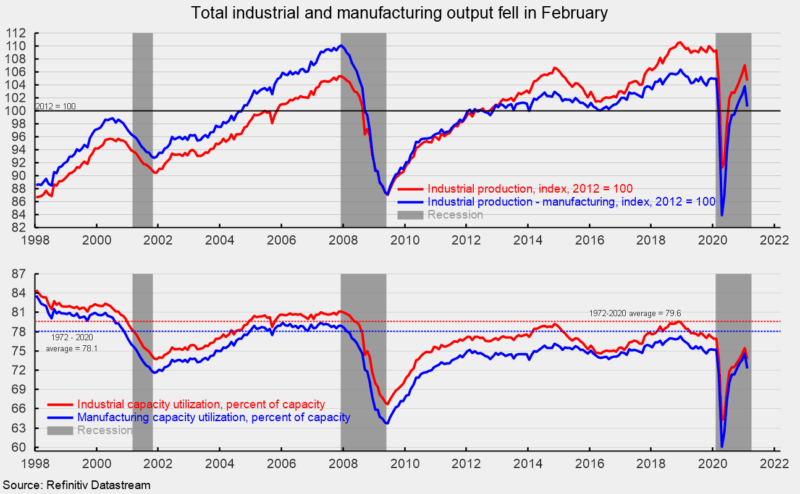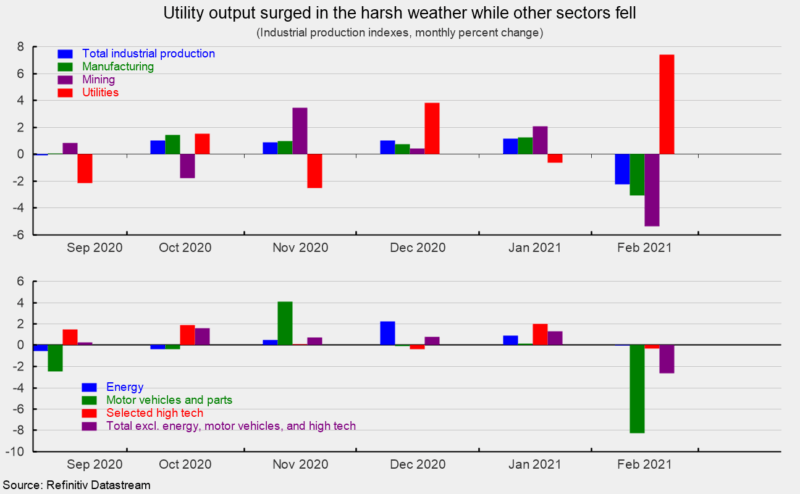Harsh Weather Sank Industrial Output in February
Industrial production fell 2.2 percent in February as harsh weather, particularly in the southern section of the country, shut a number of manufacturing and mining operations for a significant portion of the month. The Federal Reserve estimates that excluding the effects of the harsh weather, manufacturing output would have been down about half of a percent while mining would likely have been up about half of a percent. Both total industrial output and manufacturing output remain below their pre-pandemic levels (see first chart).
Manufacturing output, which accounts for about 75 percent of total industrial production, fell 3.1 percent after a gain of 1.2 in January. Manufacturing output had risen for eight of the last nine months through January including the four consecutive months through January (see top of second chart).
Mining output accounts for about 14 percent of total industrial output and posted a 5.4 percent decrease in the latest month (see top of second chart). The fall followed a 2.1 percent gain in January. Over the last 12 months, mining output is down 15.3 percent.
Utility output, which is typically related to weather patterns, is about 11 percent of total industrial output, and surged 7.4 percent for the month following a 0.6 percent decline in January (see top of second chart). From a year ago, utility output is up 10.1 percent.
Among the key segments of industrial output, energy production was unchanged for the month (see bottom of second chart) but is still down 5.8 percent from a year ago. Motor-vehicle production, one of the hardest-hit industries during the lockdowns, fell 8.3 percent in February after a 0.1 percent rise in January (see bottom of second chart). Motor-vehicle production is down 8.6 compared with February 2020. Total vehicle assemblies fell to 9.3 million at a seasonally-adjusted annual rate. That consists of 9.0 million light vehicles and 0.30 million heavy trucks. Within light vehicles, light trucks were 7.3 million while cars were 1.7 million. In addition to the pandemic and weather, the motor vehicle industry is also struggling with supply chain issues, particularly certain computer chips.
High-tech industries output fell 0.3 percent in February but is up 7.9 percent versus a year ago. All other industries combined (total excluding energy, high-tech, and motor vehicles; about 2/3rds of total industrial output) fell 2.6 percent in February and are still 3.6 percent below February 2020.
Total industrial utilization fell to 73.8 percent in February from 75.5 percent in January. That is well below the long-term (1972-2020) average utilization of 79.6 percent (see bottom of first chart). Manufacturing utilization fell 2.3 percentage points to 72.3 percent, well below the long-term average of 78.1 percent (see bottom of first chart).
February data on industrial output were severely impacted by weather and not representative of underlying economic conditions. Most other recent data have been generally favorable as the combination of the ongoing distribution of vaccines and easing of government restrictions on consumers and businesses is helping support the economic recovery. The positive momentum needs to be sustained and spread to other areas such as the labor market but in general, the outlook appears to be improving.







